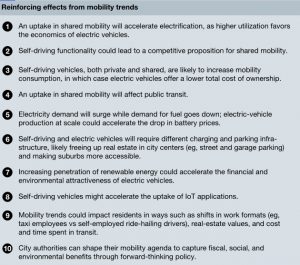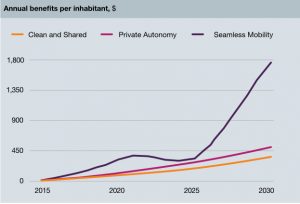Autonomous vehicles, electric powertrains, vehicle sharing, and other advances are transforming urban mobility. Planning ahead can help cities capture the benefits of the shift, from cleaner air to easier journeys.
Trends influencing urban mobility
Fast-moving trends are influencing urban-mobility systems around the world. Some trends, like vehicle electrification and the development of autonomous-driving technology, relate directly to mobility. Other, broader trends will also have important implications. The decentralization of energy systems, for example, will make a difference as modes of transportation come to rely more and more on electricity as an energy source. The following trends are likely to have the biggest impact on the development of integrated mobility in cities.
Shared mobility. Ride-hailing services have grown rapidly over the past few years and now compete not only with traditional car-sharing and car-pooling providers but also with public transit and private vehicle ownership. Investments in ride-hailing companies have taken off, too, more than doubling to $11.3 billion in 2015 from $5.3 billion in 2014.
Autonomous driving. Advances in autonomous-driving technology promise to resolve road-safety concerns, reduce the cost of transportation, and expand access to mobility. Autonomous vehicles (AVs) should turn driving time into free time. AVs could also lead to higher overall vehicle mileage, as people take advantage of their convenience by making more trips or even sending AVs to run errands for them.
Vehicle electrification. Global electric-vehicle (EV) sales have risen quickly, from 50,000 in 2011 to nearly 450,000 in 2015. Purchase subsidies, falling battery costs, fuel-economy regulations, and product improvements have contributed to the increase. Bloomberg New Energy Finance estimates that battery costs will drop below $100 per kilowatt-hour in the next decade. If that happens, EVs should achieve cost competitiveness with conventional vehicles.2
Connectivity and the Internet of Things. The spread of IoT applications into vehicles and infrastructure will generate data with a variety of uses. For city dwellers, software systems can facilitate trip planning and guide AVs based on real-time conditions. Transit authorities could use the same data to analyze the movement of people and vehicles, identify bottlenecks, adjust services, and make long-term transit plans.
Public transit. Cities around the world are expanding and improving their public-transit networks. Adding autonomous features to transit vehicles may reduce operating costs, while new deployment models such as fleets of shared vehicles can make transit more flexible and accessible. Using data from IoT-enabled infrastructure can help planners to add capacity and improve reliability so that mass transit remains competitive with private vehicles and mobility services.
Infrastructure. The United Nations Population Division projects that the world’s urban population will increase by more than two-thirds by 2050.3 Such an influx of people could put more strain on city roads, bridges, and tunnels that are already struggling to keep up with increases in vehicle miles. But infrastructure upgrades that favor public or shared transit and bicycling could reinforce a shift away from car ownership.
Decentralization of energy systems. If the cost of renewable power generation continues to fall, then intermittent distributed generation will produce a notable share of the world’s electricity over the next 15 years. These trends could accelerate EV uptake by making electricity cheaper, cleaner, and more reliable. Residential solar and energy-storage systems let EV owners recharge their vehicles without buying electricity at retail rates. (In some places, it is already less expensive to power a vehicle with electricity than with liquid fuel.) These systems also reduce demand on urban power grids, which helps to lower electricity prices at peak times and to free more capacity for vehicle charging.
Regulation. As advanced mobility services and technologies have penetrated cities, public officials at the city, regional, and national levels have responded by establishing an array of new regulations. These regulations reflect local priorities and stakeholder influences, which have not always favored integrated mobility. National or state-level regulations, such as tax breaks and incentives for EVs, have given a boost to integrated mobility in many cities, but local regulations, such as traffic rules that reserve bus-only lanes on city streets, could be even more consequential. To capture the benefits of integrated mobility, governments may want to consider creating regulations that encourage consumer-friendly developments while also promoting larger public goals, such as clean air and reduced congestion.
Individually, these trends will have a profound influence. As they unfold in tandem, their effects could be reinforced and multiplied (Exhibit 1). For example, AVs would reduce the cost difference between private car ownership and ride hailing, leading to greater use of shared mobility services. This would affect public transit: research shows that the more people use shared transportation, the more likely they are to use public transit. The adoption of both private and shared AVs should also increase mobility consumption, which would favor the adoption of EVs, since they are more economical than conventional cars when vehicle utilization rates are high.
More: www.mckinsey.com
By Shannon Bouton, Eric Hannon, Stefan Knupfer, and Surya Ramkumar

